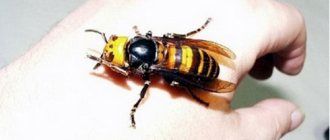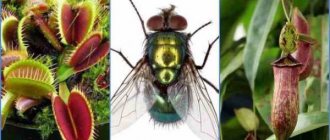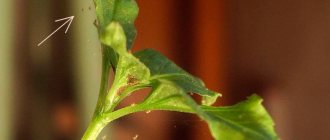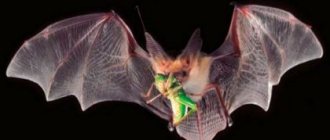Folk remedies
For opponents of chemical treatment, there are a number of traditional methods of combating the red beetle.
- Collect mechanically. You can catch the beetles themselves (it is convenient to place the caught ones in a container with soapy water) or look for their clutches, and subsequently the larvae (they are small, so it will be easier to remove them from the leaves with pieces of soft paper or fabric). The method is complicated by the fact that the beetles, when they see danger, immediately fall to the ground with their belly up, and it becomes difficult to see them.
- Shake beetles and larvae from bushes onto cardboard or polyethylene laid on the ground.
- Douse with a stream of water. But both the beetles and a significant part of the larvae will soon crawl back onto the plant.
- Spraying with natural solutions or infusions (dry mustard, ash, laundry soap, wormwood, etc.). This will scare away adult insects from the plantings, but not destroy them. Some of the larvae that have just hatched from the eggs die. Treatment is carried out at least once a week.
- Pollination with dry ash or mustard.
- During the season, cover the ground under the bushes and between the rows with film (this will also save you from weeds). The larvae will not be able to burrow into the ground for further development.
However, lilies will have to be treated in this way against red beetles many times over the course of a season. It is better to combine them, since none of these methods will bring the desired effect the first time.
Analysis of temporary relief measures
The mole can be kicked out of the area temporarily or permanently. The second methods are more difficult to implement, so we will look at them later. Temporary measures are aimed at frightening the animal or causing trouble to its delicate sense of smell. Where there is a constant stink or something making noise, the mole will not live.
Some plants are distinguished by a sharp, specific odor that comes from the roots. The sensitive mole prefers to avoid their planting sites. The most effective are beans (especially black beans), royal hazel grouse and marigolds.
The royal hazel grouse has a chic appearance, so it will not only repel moles, but will also decorate any flower garden or edge of the lawn
Marigolds planted around the perimeter of the flowerbed will scare off moles and at the same time disinfect the soil from microbes, especially if they are dug into the soil in the fall
If you plant them around the perimeter of the garden bed, then the “enemy” will not climb onto it
True, he will not leave the site, but will only crawl to the side, but if it is important for you to preserve the beauty of just one flowerbed, then these methods will be quite enough. For example, marigolds will fit perfectly into a flower garden, and hazel grouse along the perimeter of the lawn, which will fade in early spring and completely hide in the soil until the next season.
The beds can be decorated with beans, but you will have to install vertical supports, because this plant grows to a height of about 2 meters.
Legumes are unlikely to fit into a flower garden because they will overshadow the plants with their tall stems, but in the garden they will bring considerable benefits
The fight against moles is very successful using all kinds of noisemakers and rattles. The mole has very sensitive hearing, which replaces weak eyesight, and cannot stand living in such conditions (just like the rest of us!).
Spinning bottles
Many summer residents make pinwheels from plastic bottles that are set in motion by the wind. For example, they drive a pipe into the wormhole, with a long pin attached to the upper end. A plastic bottle is “placed” on this pin, having previously drilled a hole in the bottom slightly larger than the diameter of the pin. The sides of the bottle must be cut and bent with blades so that the wind has something to “catch onto.” It turns out to be a pretty strong ratchet.
Recent posts 6 varieties of delicious eggplant, suitable for long-term storage 3 ways to make your pear bear fruit faster 2 original flower beds and 1 flower garden from old tires
Pinwheels made from plastic bottles are the most popular way to scare away moles from summer cottages, although their aesthetics are not very high
If you place them throughout the entire area, then during windy weather not only moles, but also dogs will run away. True, not all summer residents like to endure constant noise.
"Singing" bottles
A good method of fighting moles is to bury bottles with high necks in the soil. It is best to use champagne containers. You need to determine which side the wind blows most often on your estate, and dig empty bottles at an angle into the soil so that the necks are directed directly to the windy side. Leave only 2/3 of the neck above the ground, and bury the rest. When there is wind, the bottles will begin to hum, thereby driving the mole out of its home. In this way, you can fence off a small space, because the entire area will have to collect containers for years or go around the neighbors.
This is how flower beds are decorated with champagne bottles, and if you turn them over and dig them in on a slope, the border can protect the flowers from moles
Ultrasonic repellers
If you don’t want to make anything, then fighting moles in your dacha can be done with ready-made products available in stores. These include electronic repellers. They run on batteries or solar energy and are a thick stick that is driven into the ground with a sharp end almost 2/3 of the way through the device.
3-4 batteries are placed inside, which are enough for the summer season (in “solar” devices, energy is absorbed during the day). Repellers buried in the ground emit vibration and a subtle unpleasant sound that is practically inaudible on the surface, but spreads well underground. True, over time, the device begins to work more and more quietly, and if it is not insulated from moisture, the contacts quickly oxidize.
The ultrasonic repeller runs on batteries, so it can be used anywhere in the garden. Battery life lasts approximately 3 months
A solar-powered repeller is placed not far from the mole passage so that ultrasound travels through the soil as strongly as possible
Measures to combat red bugs using natural methods
Protection against rattles will be effective only if all measures are carried out in combination; one of them does not give any positive results. Garden owners often have to fight pests themselves. Residents of Britain came to the conclusion that if the red bugs are not destroyed in time, they will completely destroy all the lilies and hazel grouse on the island. It is useless to wait for any help from the birds, because the fireman beetle is not tasty, as it sends a warning with its bright red color.
One of the activities is manual pest extermination. On small plantations it is not necessary to use chemicals. It is necessary to collect and then destroy red beetles manually only a few times during the summer. Collecting them is not easy, it will require some skill. Rattlers sitting openly on the grass are clearly visible, but the insect, at the slightest suspicion of danger, falls to the ground with its back down. The black-brown abdomen is at the top and practically becomes one with the ground; it is quite difficult to see beetles in this position.
Of course, the work of collecting insects, especially larvae, is very unpleasant. The only good thing is that they are not poisonous and cannot irritate the skin, as other harmful insects do. But, most importantly, see your flower garden beautiful and healthy!
How to fight?
Hand picking will be beneficial if there are few beetles and they have not yet laid larvae.
But insects are cunning and don’t fall easily into your hands. They fall to the ground and hide. The most accessible method is treatment with biological preparations: lepidocide, bitoxibacillin, fitoverm. If the invasion is large, then systemic “chemistry” is used (actellik, actara, confidor). Although inexpensive insecticides such as karbofos, fufanon, spark, inta-vir cope well with pests. The use of folk remedies is effective, but as prevention.
Important: when growing cut flowers, use chemicals only strictly according to the instructions recommended by the manufacturers. Namely, waiting times should be taken into account.
So, for the drug fufanon the period is 20 days.
Waiting times for biological drugs are shorter, from 2 to 5 days. In any case, prevention and timely inspection of plants will be beneficial and rid the lilies of pests. Bright and harmful... beetles are firefighters
Back in July, some flower growers could notice gnaws on the leaves and even petals of lilies, significantly spoiling the appearance of the flowers, especially from a commercial point of view. Since some lily hybrids still bloom in August, this question may still be relevant for some.
Who eats them?
The above-ground parts of lilies and other plants can be damaged by 2 species of Lilioceris: lily beetle
(L. lilii) and
onion rattle, or onion daylily
(L. merdigera). The first is a red beetle with a black head, 6–9 mm in size, and the second, all red on top, is found and causes harm much more often. Both species belong to the leaf beetle family, of which the Colorado potato beetle is the best known.
An adult onion beetle is a small (7-8 cm) elongated oval beetle with orange-red elytra and a black abdomen; it is also called the onion leaf beetle; it overwinters in the soil and comes to the surface at the end of April. In addition to all types of lilies, the beetle can destroy the foliage of plants of the following crops: onions, hazel grouse, tobacco, potatoes, kupena and other plants. It is worth noting that hazel grouse, especially small species, can be completely eaten by lilioceris. And not only leaves, but also green boxes with seeds.
As leaf beetles, they actively chew leaves, as well as buds and flowers. Females lay eggs from May to July.
The larvae emerging from the eggs are very untidy in appearance; Not only are they covered in mucus, they also tend to smear themselves with their own excrement. Perhaps this serves as protection for them from the burning rays of the sun. The larvae of the first instars skeletonize the leaves (eat away the soft tissue, leaving veins). The older ones gnaw pieces out of them. They feed on the plant for 2-3 weeks and pupate.
How to get rid of it. If you have small plantations, then be sure to use chemicals; it is enough to collect and destroy beetles and larvae by hand several times during the summer. The beetle usually sits openly, it is clearly visible, but you need to have some skill, because at the slightest danger it tucks its paws and falls to the ground with its back down. The black-brown abdomen blends in with the soil, and it can be quite difficult to find the pest. Of course, picking up larvae with your hands is unpleasant, but it is reassuring that they do not emit toxic and skin-irritating substances, like some other insects.
If the plantations are decent
. Many insecticides that are used against the Colorado potato beetle are suitable for spraying. The specificity of this pest is that there is always a reserve of it in the surrounding nature. If you gather, you poison some, others will come. In nature, the onion leaf beetle feeds mainly on lilies of the valley.
Of the insecticides, systemic ones are considered more reliable: Actellik (1.5 g/10 l), Aktara. Their peculiarity is that they are assimilated by plant tissues, which for some time become poisonous to the pest. However, before you buy, let alone use, this or that drug, pay attention to such regulations for its use as the waiting period - the period (number of days) that must pass from the moment of treatment to the use of plants: for Actellik it is 20 days, and for Aktars - 14. That is, lilies and vegetable crops should be sprayed with them 3 and 2 weeks before cutting, respectively. If the larvae are discovered when the buds begin to open, then these chemicals can no longer be sprayed. Accordingly, in this case, you can either collect it manually, which is disgusting, or use biological products such as Fitoverm and Bitoxibacillin, the waiting times for which are 2 and 5 days, respectively. To reduce the number of pests, it is very important to prevent them from multiplying. We must try to find and destroy all discovered larvae, preventing them from pupating.
Amateur flower growers who grow flowers often encounter red bugs.
Insects attack the beautiful thing and soon it dies.
What else to do
The appearance of aphids in my case is associated with the massive spread of garden ants. The drugs helped, but only for a while. We had to resort to additional measures: to destroy them. Additionally, in the spring I set trap belts, destroying pests mechanically.
Even schoolchildren know that birds are natural enemies of insects. And gardeners happily “forget” about this. Dousing a tree with chemicals is easier than adding bird food in winter. I repeat, the situation in the garden is out of control. I usually try to manage with conservative methods. This time it didn't work out.
I am finishing my story. What do you say, dear like-minded people, was the game worth the candle? What are you used to treating trees with? Do you think folk recipes have lost their relevance? Leave comments here, write on social networks, share the link with friends. The topic is interesting, and a fresh look at the problem is needed. This is where I say goodbye, but I promise to return. Agree, we have something to discuss!
Olga Fateeva
Scaring birds away from their habitats
If pigeons or other birds have already taken a fancy to your window, be patient, because convincing them to find another place will not be easy.
There are several ways to create uncomfortable conditions for birds:
- Foil or cellophane. Cut foil or cellophane into thin strips and hang garlands of stripes on the balcony or above the window. The wind will flutter them and create rustling noise, the birds will not like it.
- Unnecessary disks. The surface of old, unwanted CDs can also create bright glare and scare away birds. Hang them so that the wind can blow them around.
- Stuffed Toys. Our client told us about this method. She placed her granddaughter's old soft toys in the places where the birds liked to sit. The pigeons, seeing that the places were occupied, did not dare to sit next to them, and then completely forgot the way there.
DESCRIPTION OF RED BUGS EATING LILY LEAVES
The onion beetle, or bulbous beetle (Lilioceris merdigera), is a leaf beetle with a bright red body and head. The rattle has powerful jaws. Its food is not only leaves, but also buds, flowers and even stems of plants of the Liliaceae family.
If you do not destroy the pest, there will be no flowering
In nature, beetles feed on lilies of the valley, so they willingly move to areas located near the forest.
lily beetle
The lily or lily rattle (Lilioceris lilii) is a beautiful beetle, sometimes called the “squeak beetle” and “fireman”. It has an elongated oval red body and a black head. This beetle also willingly “bites” lilies.
Children catch rattle beetles, hold them in their hands, or place them in empty matchboxes to hear the faint squeaking sound that many rattle beetles make (their abdomen) when in danger.
The onion rattle, or bulbous one, came to us from Europe at the end of the twentieth century, when foreign planting material began to enter the country en masse
Important note: these bugs do not bite!. If you do not deal with the pest thoroughly, starting in spring, you will have to deal with larvae that appear in May - June from eggs laid on the underside of the leaf.
And they will be incredibly hungry. The voraciousness of the larvae is so great that they are capable of not only making holes in the leaves of lilies, but also destroying them entirely. Last year I was left with gnawed stumps from several lilies that grew behind the fence. It is difficult to notice the larvae, because they are covered in nasty grayish-brown mucus. It is needed to scare away potential enemies. The next stage of pest development is pupation in the soil (orange pupae). Then a new generation of red beetles appears and they also want to eat. The rattles overwinter under fallen leaves and begin breeding in the spring of next year.
If you do not thoroughly combat the pest, starting in spring, you will have to deal with larvae that appear in May - June from eggs laid on the underside of the leaf. And they will be incredibly hungry. The voraciousness of the larvae is so great that they are capable of not only making holes in the leaves of lilies, but also destroying them entirely. Last year I was left with gnawed stumps from several lilies that grew behind the fence. It is difficult to notice the larvae, because they are covered in nasty grayish-brown mucus. It is needed to scare away potential enemies. The next stage of pest development is pupation in the soil (orange pupae). Then a new generation of red beetles appears and they also want to eat. The rattles overwinter under fallen leaves and begin breeding in the spring of next year.
Onion hoverfly
If in late spring - early summer, while caring for lilies, you hear a quiet murmur, look around. Do you see small black flies hovering over the flowerbed? Know that your flowers are in danger. These are onion hoverflies and they have most likely already laid eggs in the soil. Soon the larvae will appear, which with an exorbitant appetite will bite into the bulbs and turn their insides into a putrefactive mass.
Control measures . Before planting, dust the bulbs with Bazudin. During the mass summer of flies, treat the plants with Karbofos or Inta-Vir. And in the fall it is necessary to dig up the soil and mulch the lilies with peat.
Fungal diseases
Most often they are the result of improper maintenance, so first of all you need to optimize the care of your garden. Blooming lilies are affected by dangerous fungi primarily during the rainy season, so it is advisable to carry out preventive treatment before the rainy season. In first place is botrytis, or gray rot, as this disease is popularly called. The infection spreads very quickly, first affecting the leaves, then the stem and buds. If the weather is favorable for the development of the disease, then in just a few days your plant can turn into a rotting monster. This fungus is very fond of the month of August, with its night coolness, dew and rain. Preventive treatment can be carried out using the drugs “Hom”, “Oxychom” and others. To prevent this disease, you need to remember that you need to water lilies in the morning, not in the evening, at the roots, not at the leaves, and only with warm water.
All types of garden lilies are susceptible to another fungal disease - root rot, or phytium. It may be caused by contaminated soil. The top of such a lily turns yellow, the plant lags behind in growth, the leaves become smaller, and the buds fall off. If you dig up the bulb, you will see that it is healthy, and the roots are covered with brown spots. If the disease has not developed too much, then try removing all affected areas, disinfecting the bulb and planting it in another place.
Treatment of diseases
Lily has diseases, and their treatment depends on timely prevention. Every gardener should know what diseases lilies suffer from and the existing methods for preventing these diseases. Before planting, the bulbs should be carefully inspected for damage. It is imperative to carry out bactericidal treatment at the slightest suspicion of rot. Treat the soil before planting.
How to cure fusarium
Fusarium affects the roots of lilies. If you notice that the tops of the leaves have turned yellow, the base of the stem is rotting, and the plant has begun to dry out - this is fusarium. To combat it, fluff lime or ash should be used. Spray plants with Topsin-M or Fundazol. If the plants are completely affected, they need to be dug up and destroyed.
Bacterial rot
If you notice rusty spots of varying sizes on your lily, this is most likely bacterial rot. If you do not fight this disease, the leaves will gradually begin to die, the buds will fall off, and the lily will dry out. To combat rot, use phosphorus or potassium fertilizers, add wood ash, treat the plant with Bordeaux mixture, Fundazol or Benomyl.
Did you know?
Many diseases and pests can be transmitted from nearby plants or weeds. For prevention, it is worth spraying not only lilies, but also the space around them.
Root rot
Root rot affects lily bulbs. They become covered with brown spots, the plant begins to grow slowly, and the buds fall off. Gradually the stem of the lily dries up. To combat the disease, carefully select planting material, disinfect the soil with colloidal sulfur and treat the bulbs before planting. Affected plants should be removed and destroyed.
Penicillosis
With penicillosis, the lily's flower stalks rot, and the flowers and bulbs become covered with a green coating. This is a very dangerous and common disease of all bulbous plants. To prevent the disease, it is worth spraying the plants and treating the bulbs with fungicides. Affected plants must be removed from the site and destroyed so that the disease does not spread to healthy lilies.
Viral diseases
Viral diseases are more difficult to fight than fungal diseases. They are difficult to treat and diagnose. Viral diseases are transmitted by insects and garden tools. The most common are:
- variegation virus - transmitted from tulips. It is distinguished by the unusual spotted color of its flowers. It can be carried by aphids,
- rosette - delayed growth of flower shoots, deformed stem, crooked and yellowed leaves. The main vector is aphids,
- mosaic - spots and stripes on the leaves.
A lily affected by mosaic may bloom and produce seeds. But they will already be infected with the virus. Over time, the lily will die, and the planted seeds will again spread the virus, which can be transferred to other plants by aphids.
In order to avoid infection of all plants with viruses, first of all you should pay attention to their carriers and engage in the fight against insect pests
Processing Features
The main way to protect trees in the spring is to spray them with pesticides or products prepared according to folk recipes.
Low trees and seedlings can be treated with homemade spray bottles or a watering can with small holes. A ladder is installed next to the tree, the solution is poured into a watering can, and the tree is sprayed from above. For tall plums, it is better to use a spray bottle with a long holder. There are general rules that must be followed:
- Before starting work, mature plum trees are pruned, the trunks are cleared of dried bark, and the soil in the circles near the trunk is loosened;
- treatment with solutions begins from the outer branches, gradually moving to the skeletal branches and trunk;
- the water pressure should not be too strong, otherwise the solution will not linger on the branches;
- To make the product stick better and stay on the tree for a long time, you need to add a little laundry soap to the water.
When working with aqueous solutions, it is necessary to use personal protective equipment:
- special glasses that fit tightly to the face;
- respirators or gauze bandages;
- latex gloves;
- a hat or scarf (preferably made of polyethylene);
- special clothing (overalls or raincoat).
These remedies should not be neglected to avoid chemical burns to the eyes and skin. Chemical solutions can also cause allergic complications.
Agrochemicals
Chemical agents are considered the most effective for treating gardens against pests and diseases. Ready-made concentrated liquids and powder mixtures are available for sale. Their range is significant, there is plenty to choose from.
Preventative
An insectocaricide is used in early spring to control overwintered insects (adults and larvae).
When spraying plums with Prophylactic in March-April, the reproduction of pest colonies is suppressed, mites, leaf roller larvae, and aphids are destroyed. Manufacturers produce the finished liquid product in 500 ml plastic bottles. Attention! Before use, you must read the Instructions. The concentration of solutions should be observed and the dosage should not be exceeded.
Tanrek
The enteric contact drug (insecticide) is produced in ampoules and vials. One package is enough to process 5-6 adult trees or 7 seedlings. The product effectively destroys aphids, whiteflies, codling moths, and flea beetles. There are many analogues of Tanrek: Biotlin, Bison, Imidor, Korado, Tabu.
The solution affects the nervous system of pests, paralyzes it, causes convulsions and death of insects. The period of action of the drug is at least 30 days. Plant protection also occurs in the soil; the substance disintegrates only after 50 - 100 days. Effectively affects beetles and non-arthropod insects.
You may be interested in: How to treat fruit trees in the fall from diseases and pests There are countless diseases and pests, and each gardener and gardener will certainly encounter...Read more...
Bordeaux mixture
Small blue crystals dissolve well in water. Solutions are used for spring treatment of gardens against fungi and other pathogens. The main active ingredient, copper sulfate, does not harm plants.
Preventive spraying of plum trees protects them from damage: gray and brown rot, powdery mildew, late blight, rubella, scab, leaf curl and spotting.
Fitoverm
This product is considered one of the most popular for treating garden and indoor plants against pests: mites, sawflies, leaf rollers, moths, whiteflies, thrips, aphids.
The liquid concentrate is sold in ampoules (2, 4, 5 ml) or bottles (10, 30, 50, 100 ml). Before use, you need to dilute it with water according to the instructions.
After a few hours (from 6 to insects coming into contact with the solution, paralysis occurs. After 2-3 days, the pests die. The effect of the drug lasts up to 7 days. The first spraying of plums is carried out in early spring. During the growing season, trees should be treated at least 3 times at intervals in 2-3 weeks.
insects coming into contact with the solution, paralysis occurs. After 2-3 days, the pests die. The effect of the drug lasts up to 7 days. The first spraying of plums is carried out in early spring. During the growing season, trees should be treated at least 3 times at intervals in 2-3 weeks.
Lepidocide
You can treat plums for worms in the fruits with this effective remedy. For prevention, trees and seedlings are sprayed with Lepidocide solution in early spring. It will be necessary to repeat the treatment after fruiting if some berries have been damaged by worms and insect caterpillars. Indeed, as a result of the action of these voracious pests, the fruits rot and the yield decreases.
The product is produced in the form of a powder, a concentrated suspension, and a modified suspension concentrate. Lepidocide has a fourth hazard class and does not harm humans or animals. It repels bees with its scent, thereby protecting them from their harmful effects.
The effect on pests lasts 2-3 days. Gnawing insects stop feeding and die.
Copper sulfate
A popular universal remedy helps get rid of pests and protects plants from fungi, rot and mold. In the spring, before the buds open, the plum is treated with a solution of copper sulfate. Spraying should be done before flowering, before bees arrive in the garden.
The product is used for preventive treatment of fruit trees in spring and autumn, as well as for feeding purposes when there is a lack of copper in the soil.
Harm in the garden
Leaf beetles moved to summer cottages relatively recently: back in the 90s they lived exclusively in forests. Today, the lily beetle is found quite often in the garden, and you need to know how to deal with it.
Did you know?
The larvae envelop themselves in mucus from their own excrement.
In this way, they protect themselves from birds that ignore young individuals, which they mistake for their excrement. Undoubtedly, adult individuals are capable of causing damage to plants in the spring, but it is not so great and cannot lead to the death of the flower. You need to beware of the larvae: they appear on the lower part of the leaves a little later and are orange in color. Over the course of one season, one leaf beetle lays approximately 450 eggs, which can hatch into several generations.
About a week after the eggs are laid,
pink larvae appear. They are located under the leaf, so they are quite difficult to notice right away. The larvae are very voracious and can eat all the leaves on a flower, leaving only the stem. After 2-3 weeks they move to the soil, where they begin to transform into orange pupae. After 3 weeks, the red pests go hunting. For the winter they hide in the ground or fallen leaves.
Important! When planting lilies, it is worth laying garden film between the rows - this will prevent the beetles from burrowing into the ground, and you can quickly destroy them.
Leaf beetles attack plants very quickly, and sometimes you may not have time to enjoy the beauty of the flowers.
The appearance of a beetle
Female lily beetles lay eggs on the undersides of leaves in a grey-brown mucus, so inspect the plant if you spot the pest.
Within a week, larvae appear and begin to devour all the green parts of the flowers. Lilies will begin to lose their decorative properties, growth will be inhibited, there will be a lack of flowering and the bulb will weaken.
After a month, the larvae of the lily beetle go to pupate in the soil, only to emerge after 21 days as a fully formed beetle. They have a huge appetite, starting from young leaves and ending with buds. In most cases, beetles do not touch the underground part of lilies.
The pest overwinters under the cover of leaves, but not necessarily in the same area where there are lilies, so treating the soil in late autumn against the lily beetle is pointless. Their flight should be monitored in early spring when the first lily leaves appear.
Sometimes the lily beetle can be seen on hazel grouse and lilies of the valley.
Controlling red beetles using chemicals and biological control methods
It happens that manual collection does not bring any results and the “red invaders” aggressively go on the offensive, which means it’s time to use the “heavy artillery”, which consists of chemicals. They are used only when large numbers of larvae appear when the lilies are not in bloom.
Currently, there is no drug that would be intended to destroy lily pests - red beetles. In cases of invasion of rattles on plants, chemicals that can infect other leaf-eating insects are used to combat them. These are especially often used in the fight against the Colorado potato beetle.
Red beetles have become resistant to chemicals. Before choosing any of them, you should take this into account. To date, the following modern drugs have proven to be the most effective: Inta-Vira, Decis, Fufanon, Talstar, Kinmiks and others.
If the flower garden is large and a considerable number of pests have accumulated, you can spray with products that are used to combat the Colorado potato beetle. The solution must be prepared according to the attached instructions, otherwise the plant can be burned, while the pests will remain alive.
Still, “chemistry” is not one of the best ways to combat harmful insects, including red beetles. Whatever insecticide you choose, no matter how its merits are advertised, it, in fact, was and remains a poison that causes great harm to nature.
In 1996, French scientists began large-scale research, which they then conducted in European countries on lilies during the very season of the appearance of the red beetle. More than 1,000 eggs, about 30,000 larvae and many thousands of adult red beetles were delivered to the laboratory for research.
In order to have healthy lily plants in your garden, you need to prepare in advance for protection from small and large pests, including red fire beetles. You need to purchase the necessary medications and a good sprayer, prepare everything so that you can start the fight for the health of your pets on time
It is important not to forget that the beauty of flowers is in the hands of the owner!
In recent years, all amateur gardeners growing lilies have encountered a serious problem. Its cause and other troubles are associated with the massive spread of voracious red bugs of a large family of
Leaf Beetles
,
the genus Lilioceris
.
Cute rattle beetles are active and incredibly voracious
Two common types ruin our lives. This is, first of all,
onion
rattle ,
bulbous
, or
bulbous daylily
(L. merdigera).
The lily beetle
, or
lily rattle
, and
lily beetle
(L. lilii), known as the "
fireman
", also cause damage. The pest eats away the leaves so much that often only the stem remains of the plant. Then there can be no talk of any flowering.
Last summer I began to notice these red bugs on the wide leaves of the imperial hazel grouse and daylily. They are just looking at these plants for now. Lilies of the valley are not touched either.
Potato scoop
Lily pests such as cutworms eat away plant trunks from the inside. As a result of such damage, the flower breaks or fades. The caterpillar also has a bright red line running along its back. The eggs of these caterpillars spend the entire winter on wild cereals, and in the summer they move to flowers and other cultivated plants. Pupation occurs in the soil next to damaged plants at a depth of five to fifteen centimeters.
To prevent the invasion of cutworms on lilies, it is necessary to thoroughly clean your area of weeds, as well as all kinds of plant debris. All this must be collected and destroyed.
Fighting methods
Folk remedies
Removing red bugs can be very simple if you start early. But it is advisable to fight the soldier if the area is heavily infested. You can get rid of pests in your garden mechanically, using folk remedies, and in rare cases using insecticidal preparations.
Affected leaves are torn off, thrown away from the site or burned. The plant itself is treated with a product prepared according to one of the folk recipes:
Add wood ash and laundry soap to the water. Stir thoroughly
Water the plant, paying special attention to the underside of the leaves. Ash does not kill wingless red bugs, but it actively repels
Soap promotes better adhesion of active particles and covers the leaves with a protective film. The ash penetrates the plant juice, makes it taste bitter, and also causes a burning sensation when it comes into contact with the body of an insect. It should be removed by spraying every 7 days. Add red and black pepper, mustard, cinnamon, and laundry soap to the water. Spray the plant. The product has a repellent effect. They will have to withdraw several times. Dilute green soap in water and spray. The product has an insecticidal effect, heals wounds after numerous punctures, and restores the plate.
Insect repellents
Herbal medicines act more slowly, but can be used at any time during the plant growing season. Effective product Fitoverm. Before eating the fruit, the greens should be rinsed well under running water. It will work on bedbugs within a week. Complete destruction occurs in a month with two treatments.
To combat bugs with soldier bugs, certain measures are required, so it is very important to know for sure that your area is besieged by these pests. There are signs of damage characteristic of these harmful insects:
There are signs of damage characteristic of these harmful insects:
- buds and flowers fall;
- cabbage leaves become covered with yellow spots and partially die;
- umbrella plants dry out very quickly;
- the beet tops curl and dry;
IMPORTANT! The soldiers must be destroyed the first time they appear on the site. These insects lay eggs in plant stems, which are subsequently destroyed by the emerging young
How to deal with uninvited guests and prevent their further possible appearance?
- garden crops should be interspersed with black cohosh. This fragrant plant can repel bedbugs. They will leave your suburban area forever;
- alfalfa and legumes should be planted away from fruit and berry crops, since toy soldiers overwinter on these plants and will appear on your site in early spring;
- Bankol is an absolutely harmless product for people and animals that has a detrimental effect on bedbugs. 7-10 mg. the powder is diluted in 10 liters of water and sprayed on all vegetation;
- it is necessary to monitor the cleanliness of the area, weed weeds in a timely manner, and burn the grass;
- it is advisable to have a strip of clean land between the weeds and the garden, this will also help protect your land from the influx of bedbugs;
- treat the area with insecticidal agents against the Colorado potato beetle. It must be remembered that insecticides kill not only pests, but also beneficial insects. Chemicals also harm the crop and its environmental friendliness;
- treat the area with a decoction of onion peels;
Must know: first aid for a victim of a poisonous snake bite
These rules need to be memorized. They will be useful to you if you have just discovered these uninvited guests in your possessions and have not yet begun to fight them. Everyone is at risk of being bitten by a snake, so remember what the victim needs to do.
- Drink plenty of water, it will help speed up the removal of poison from the body and slow down its absorption. At the same time, try to move as little as possible and not panic, so as not to cause tachycardia.
- Avoid drinking tea and coffee: these drinks speed up blood circulation. Drinking alcohol is strictly prohibited if you are bitten by a poisonous snake. You can’t even treat a wound with alcohol: ethyl thins the blood, speeds up its flow through the vessels, and the poison quickly spreads throughout the body.
- Do not cover the wound with a bandage: this can cause harmful substances to stagnate at the site of the bite, which will lead to tissue infection.
- You can immediately after a bite carefully suck out the blood and poison from the wound. But it is worth remembering that any wound on the oral mucosa, and even a decayed tooth, can serve as a path for poison to enter the body. At the same time, swallowed poison is not at all dangerous to the body: the mucous membrane of the stomach and esophagus is immune to this substance.
- After the poison is removed from the wound, the edges of the bites can be treated with brilliant green, iodine or alcohol. But in no case should you use oxidizing substances, for example, potassium permanganate, as well as alkalis or objects heated on fire.
- A person who has been bitten needs to lie down so that his head is lower in relation to his body: this makes it easier for blood to flow to the brain.
After all preliminary measures have been taken, be sure to take the victim to the hospital, where he will be injected with the appropriate serum.
Keep a first aid kit with the necessary supplies at your dacha
Always keep a first aid kit nearby, containing the following items:
- antipyretics;
- painkillers;
- anti-inflammatory;
- antiallergic;
- drugs for the cardiovascular system and high blood pressure;
- antibiotics.
If there are too many snakes on your property, or you are afraid to get rid of them yourself, then it is better to contact herpetologists. But if you are in the mood for a serious fight, then our advice will be useful to you.
Pests of lilies and their control
It so happens that insects love to feast on all varieties of lilies. Today there are 15 main pests that affect lilies. In this case, one must take into account the fact that they can not only eat all fragments of the plant, but also carry various diseases.
The most dangerous pests for lilies are presented below.
Red beetles on lilies
Red beetles on lilies
There are red bugs on lilies, how to get rid of them? This problem is quite common and occurs if a flower lover does not follow the rules of crop rotation in the flowerbed and does not carry out preventive irrigation of the bushes.
Has alternative popular names:
- squeak beetle,
- bulbous rattle,
- lily beetle.
It is quite easy to find due to its bright red color; the larvae are pink and covered with a special protective mucus that inhibits plants.
The main symptoms of damage are the wilting of the plant; it is very easy to see insects and their larvae on the aboveground part of the crop.
Spider mite
A pest that drinks all the juices from a plant, causing it to wither.
Important! A terrible feature of the insect is that the eggs of the species are able to live in the soil for more than 5 years and are highly resistant to many drugs. The main symptoms of the lesion are the gradual drying of the bush, the leaves curl, and the buds fall off. If you look closely, you can see threads of cobwebs, many white eggs and adults on the leaves
If you look closely, you can see threads of cobwebs, many white eggs and adults on the leaves
The main symptoms of the lesion are the gradual drying of the bush, the leaves curl, and the buds fall off. If you look closely, you can see threads of cobwebs, many white eggs and adults on the leaves.
Spider mite
Caterpillars on lilies
This is a real problem that can lead to the death of the plant.
The insect lives in the soil and overwinters there. When the bush is damaged, it begins to literally eat flowering shoots and bulbs.
The greatest damage is caused during the rainy period and in areas where a large amount of weeds grow, since butterflies lay eggs exclusively on weeds.
Rodents
How to protect lilies from rodents in the country? These questions concern everyone without exception, since rodents severely damage the plant. As a rule, after such damage it simply dies.
How to plant lilies without being eaten by mice? There is one simple but proven method - before planting the bulb, treat it with diluted Vishnevsky ointment. By the way, this treatment also protects the plant not only from rodents, but also from some insects and diseases.
Mice
Other pests
Less common “lovers” of lilies:
- The lily fly attacks uncolored lily buds. The defeat will become more obvious when the entire inside of the bud is eaten, and the fly quietly pupates in the soil.
- The Colorado potato beetle is an insect that lays its larvae on the back of the leaf blade; this happens from June to August. In the near future, the eggs hatch into young individuals that infect all fragments of the aboveground part of the lily.
- Slugs. Black slugs appeared on the lily - the picture, of course, is not a pleasant one. Moreover, the plant soon begins to fade before our eyes. Mollusks become active in rainy and humid weather and affect all above-ground parts of the plant. Getting rid of them is not so easy, since fungicides and insecticides are effective against insects, but not against molluscs.
- Thrips are dangerous because they suck all the juices out of crops. Silver spots always form in their habitat (this is perhaps one of the most obvious signs of damage). Next, insects penetrate the buds, as a result, the latter, before they have time to open, become discolored and fall off. They overwinter in lily bulbs; if the air temperature does not drop below +10 degrees, they remain active. Affected bulbs are usually covered with a red dense crust.
Methods for controlling lily pests will be discussed below.
Most common types
Raspberry flower beetle. It has a black three-millimeter body. The wings have gray fibers and longitudinal grooves. The larvae are white with a yellow-brown head. In the initial stage, the pupae are white, but before the beetles emerge, they darken. They wait out the winter under the remains of vegetation.
They begin to feed when the first greenery appears. When the strawberries and raspberries form buds, the female weevils gnaw a hole on the side and lay an egg in the bud. Then the female gnaws the peduncle, causing it to break off and the bud with the egg to fall. A week later, a larva hatches from the egg and lives and feeds in the bud for a little over three weeks. Afterwards pupation occurs. After about 10 years, a crimson flower beetle appears.
In mid-July, a mass emergence can be observed. By the end of the month, the insect begins to look for shelter for the winter. One female flower beetle lays about 100 eggs, which first damage strawberries and then attack raspberries.
Southern gray weevil. This omnivorous beetle can fly. It begins to feed when the first greenery appears, often on winter crops. Switches to corn, beets, sunflowers. It also affects weeds. The length of the dark body is 7-8 mm, the wings are developed.
After wintering, which the insect spends in the ground, often in a field after corn at a depth of about 0.5 m, they emerge from the ground and mate after 10 days. After this, the female lays about 300 eggs in the soil, to a depth of 20 cm. Laying is carried out in small groups - up to 10 eggs. The larvae feed on plant roots, which they eat for 60-70 days. The insect spends about 20 days in the pupal stage. Adults appear in early August.
Stone fruit beetle. A dangerous pest that attacks stone fruit crops. Adults feed on leaves and buds. The larvae live in the stone fruits of the following trees:
- plum;
- bird cherry;
- cherry;
- cherries.
The beetles reach 4-5 mm in length and are yellow-brown in color without shine. In the spring, when the ground warms up to 9 ° C, overwintered insects crawl out of the ground and begin active feeding. When young fruits set, the female gnaws through the still soft shell of the stone and lays an egg. The development of the fetus occurs in the stone. In order for the young beetle to have the opportunity to get out, it must gnaw through the hard shell for about two days. When the flower beetle leaves the fruit, it climbs into the soil and prepares for wintering.
Weevils that feed on deciduous and coniferous trees can cause great harm. The granary weevil will also cause trouble - it damages grain crops during their growth period and stored grain.
What to do if red bugs eat lily leaves?
In recent years, all amateur gardeners growing lilies have encountered a serious problem. Its cause and other troubles are associated with the massive spread of voracious red bugs of a large family of Leaf Beetles, the genus Lilioceris.
Cute rattle beetles are active and incredibly voracious
Last summer I began to notice these red bugs on the wide leaves of the imperial hazel grouse and daylily. They are just looking at these plants for now. Lilies of the valley are not touched either.
Gray rot, brown spot, rust, botrytis on lilies
All of the above is the name of the same disease; it is caused by infection of plants with spores of the fungus Botrytis elliptica. At the beginning of the disease, small brown, less often red-brown, round spots with uneven, watery edges appear on the leaves. If the disease progresses, the spots grow, merge, capture the stem of the plant, and penetrate into it. The leaves lose their ability to photosynthesize, the lily turns yellow, and the stem dries out until it completely dies.
Active carriers of the disease are insects that carry fungal spores on their legs. LA hybrids, LO hybrids and Asian Hybrids are the most unstable to botrytis. Under unfavorable weather conditions (cool, windy, rainy summers), all measures to protect and treat them may be in vain. But there is a consoling bonus - brown spot is content with the tops and does not touch the roots (bulbs).
Prevention and control of botrytis:
- Treat the bulbs with a TMTD suspension (0.5-1%) or “Fundazol” (0.2-0.5%).
- Do not spare wood ash for each bulb.
- Regularly, at intervals of 7-10 days, spray diseased plantings with fungicides (Bordeaux mixture, Zineb, etc.).
- Do not plant densely.
- Weed out weeds, they are often carriers of disease.
Thrips
In some cases, the root system of lilies is parasitized by small insects that have an elongated shape. They are called thrips. Their mouthparts look like a proboscis. These pests pierce the plant tissue and suck the juice out of it. After this, the plant weakens greatly, and its appearance loses its attractiveness. But the most dangerous thing is the transmission of various viral diseases by thrips. In a year, these parasites can form from three to eight generations. All this depends on the type of pest, as well as on the temperature and humidity of the environment. The number of generations becomes significantly smaller if the ambient temperature decreases. This is primarily due to an increase in the life cycle.
These insects can be controlled using any systemic insecticide. This could be, for example, “Karbofos” or “Fitoverm”. They begin to process plants with the arrival of spring. Subsequently, processing is carried out every ten or twelve days.
All lily pests, photos and descriptions of which are presented in this article, are the most common and frequently encountered in garden plots. But this does not mean at all that our list is exhausted. In addition to the insects discussed, there are others that infect these plants less frequently and also carry various diseases of viral and non-viral origin. But this is not a reason to despair and refuse such beautiful flowers on your site. The main thing is to study the available information and carry out preventive and therapeutic measures in a timely manner. Then your daylily will look wonderful and delight your eyes with bright and healthy flowers.
Spider mite
A well-known pest that feeds on the sap of young shoots. Forms huge colonies and can “suck” the plant to death. The first signs of infection are the leaves starting to curl. If you look at them closely, you can see small red dots - these are ticks.
Control measures. Treat the plants with any acaricide, for example “Aktellik” or “Fitoverm”. The main thing is to do this as early as possible, while there are few pests.
Distribution and behavior of toy soldiers
Ladybugs are distributed throughout the world. They live on all continents of the world except Antarctica. Ladybugs inhabit open spaces with herbaceous vegetation - gardens, meadows, forest edges, steppes, and less often - forests.
The peculiarity of these beetles is that when threatened, they secrete a rather sharp-smelling, poisonous yellowish liquid that scares away enemies. Only a few species of these beetles are harmful to crops.
The ladybug is not always a red beetle with black dots (the photo demonstrates this). Some of the varieties have a yellow outfit with black dots, others are black with red dots.
Beetles live in temperate climate zones in Eurasia, and are also found in North Africa and North America. The bug can be seen at almost any time of the year, except winter. There are especially many of them in the spring, when the sun warms up well. They sit in small groups in open areas.
The composition of their diet includes fruits that have fallen to the ground, seeds, and plant juice. Their main feature is that they sometimes eat their relatives when they live in large colonies.
At the end of autumn, beetles with red backs and black dots lie down for the winter under fallen leaves, under the bark of trees and in other places sheltered from the wind and severe frosts. With the onset of winter, soldiers enter the adult insect stage. Nature has endowed them with an unpleasant odor to repel natural enemies.
Lifestyle, nutrition
The squeak beetle is active in the warm season - from May to August. The mating season begins at the end of spring, larvae begin to appear in June, and by the end of August a new generation of young adults emerges. The lily beetle lives in numerous colonies and prefers lilies of different varieties. When there is a lack of food, it settles on hazel grouse, lilies of the valley, and weeds.
Lily beetle
It is active during the day and sits motionless on plants at night. The larvae live on the underside of leaves, hiding from direct sunlight. Some species of birds feed on adult beetles. The main enemies for the larvae are ground wasps. They lay eggs on the body of a living victim, after a few days the young appear and begin to eat it from the inside.
The red beetle has a good appetite. Within a few days of living on the plant, the lily begins to wither, ache, and fade. If you do not respond to the problem in a timely manner, the flower dies. In addition to lilies, the red-backed onion beetle feeds on potatoes, tobacco, onions, and hazel grouse.
The red lily beetle pest lives for several seasons. With the onset of cold weather, young individuals burrow into the ground, tolerate frosty winters well, crawl to the surface in the spring, begin to mate, and lay eggs. By the end of August they die, leaving the young generation, the pupae, to overwinter.
Description of the pest
The fire beetle belongs to the Leaf Beetle family and poses a great threat to the leaves of the flower. Today, two types of pests are often found: onion rattle and lily rattle. Insects eat a lot of foliage; sometimes you can find a plant with a bare stem.
- Onion rattle
. This pest is a member of the leaf beetle with a bright red body and head. Thanks to its powerful jaws, the pest can eat not only foliage - its prey is the buds, flowers and stem of the plant. The main targets of leaf beetles are lilies of the valley and lilies. That is why they have another name: “lily beetle”. - Lily rattle
. Another pest of lilies is the so-called red beetles. They have a rather attractive appearance and have rigid wings. People call such pests “firemen” because of their colors. They have an oblong red body and a black head.
Often children catch and place insects in a small box - while doing so, a cracking sound can be heard from it, which gives the name to the pests.
House grinder
In tree houses, a black bug with several golden spots of hairs appears as a frequent guest; its size does not exceed 5-7 millimeters. This type of insect does not chew furniture, preferring wooden structures. These wood beetles are often found in village bathhouses, since damp coniferous wood is an ideal habitat for them. The house borer can also be found in attics, especially at the ends of beams, where leaking water sometimes gets in; they can also live under windows and in the kitchen. Fresh wood is of no interest to bugs. The presence of a pest can be guessed by the presence of holes and dust spilling out of them.
Treatment options
Gardeners who are experienced in growing lilies advise starting treatment of plants at the first signs of illness - it is timely assistance that can save your green “pets” and prolong their life. Let's consider popular methods of treatment with special and folk remedies.
Special means
All the drugs that will be mentioned below can be found in flower shops.
- HOM, Oxychom, and Bordeaux mixture help well against botrytis. Spraying with these solutions is carried out at the first signs of the disease.
- In order to protect lilies from fusarium, disinfect the soil with copper sulfate and formaldehyde about a couple of weeks before planting the bulbs. It would be a good idea to keep the bulbs themselves in the Fundazol solution (0.2%) for at least 30 minutes. Spray the planted young animals with Bavistin once every week and a half; you can also use Topsin-M (0.2%) or Euparen.
- If you notice signs of cercospora, irrigate your lily plants with Bordeaux mixture (1%) or with Topaz, HOM, Abiga-Peak. Once every 3 weeks, spray with a solution of “Alirin” and “Gamaira” (take 2 tablets of each, dilute in 10 liters of water).
- To combat anthracnose, you will first have to get rid of the affected foliage in order to prevent the spread of infection, and then spray the lily with fungicidal agents: “Fundazol” (15 g per 10 liters of water), “Rovral” (1 g per 1 liter of liquid).
- “Abiga-Pik” (50 g per 10 l), “HOM” (40 g per 10 l), “Fundazol” (20 g per 10 l) can cope with rhizoctoniosis.
- Phythium will be eliminated by removing all infected areas of the lily and pre-treating the soil with a cumulus solution (0.4%).
- As we remember, a plant can become infected with blue mold during the period of storage of planting material. This means we inspect and reject diseased onions, follow all recommendations for their storage, ventilate and disinfect the room.
- If you notice signs of penicillosis, soak the planting material in a solution of potassium permanganate (0.2%).
- Rust is prevented by removing infected foliage and then burning it, spraying the plant with a Zineba solution (0.2%) and regular fertilizing with fertilizers containing potassium and phosphorus.
- The cucumber and tobacco mosaic viruses, as well as the variegation of tulips and rosettes, will be eliminated by first fighting the causative agent of diseases - aphids. For this, it is recommended to irrigate lilies with a solution of Karbofos (0.3%). If mosaic “patterns” have already appeared on the flowers, the affected parts should be removed or even the entire plant should be destroyed.
And now we will tell you about what products will help in pest control.
- Spider mites will be destroyed if you spray the lilies with a soap solution or Karbofos (0.2%). Treatment should include irrigation of the tree trunk circle, as well as the entire plant.
- The squeak beetle is afraid of insecticides (Decis, Intra-Vir), as well as the aforementioned Karbofos (0.2%). The same goes for the lily fly.
- If a mole cricket has been spotted on the site, plant Tagetes next to the lilies - its aroma will repel these harmful insects.
- Any caterpillars will be controlled by carefully weeding the lily bed and digging the soil deeply every fall. It is also recommended to treat the plants and soil around with insecticides.
- Slugs are afraid of Metaldehyde. Granules of the drug are laid out under the bushes in 3-4 pieces.
- You can fight aphids by spraying lilies with insecticidal preparations.
Traditional methods
No one disputes that special preparations artificially synthesized in laboratories help gardeners out. However, not everyone likes to treat plants with chemicals, and then time-tested folk remedies come to the rescue.
- Before planting, it is recommended to soak the lily bulbs in a weak solution of potassium permanganate for half an hour. This helps protect plants from many diseases and pests.
- For mole crickets, flower growers offer the following remedy: take a couple of liters of soapy water, pour it into the mole cricket’s location and wait a little. The insect should soon appear on the surface, then it can be caught and destroyed.
- We destroy aphids: take garlic (3 or 4 heads), chop it, add 1 liter of water and leave for 3-4 days in a container with a nylon lid. Next, dilute 25 ml of tincture in a 10-liter bucket of water and spray the lily plantings.











